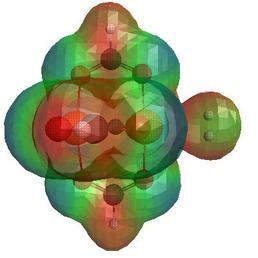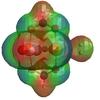GAMESS(US)

GAMESS is a program for ab initio molecular quantum chemistry. Briefly, GAMESS can compute SCF wavefunctions ranging from RHF, ROHF, UHF, GVB, and MCSCF. Correlation corrections to these SCF wavefunctions include Configuration Interaction, second order perturbation Theory, and Coupled-Cluster approaches, as well as the Density Functional Theory approximation. Excited states can be computed by CI, EOM, or TD-DFT procedures. Nuclear gradients are available, for automatic geometry optimization, transition state searches, or reaction path following. Computation of the energy hessian permits prediction of vibrational frequencies, with IR or Raman intensities. Solvent effects may be modeled by the discrete Effective Fragment potentials, or continuum models such as the Polarizable Continuum Model. Numerous relativistic computations are available, including infinite order two component scalar corrections, with various spin-orbit coupling options. The Fragment Molecular Orbital method permits use of many of these sophisticated treatments to be used on very large systems, by dividing the computation into small fragments. Nuclear wavefunctions can also be computed, in VSCF, or with explicit treatment of nuclear orbitals by the NEO code. A variety of molecular properties, ranging from simple dipole moments to frequency dependent hyperpolarizabilities may be computed. Many basis sets are stored internally, together with effective core potentials or model core potentials, so that essentially the entire periodic table can be considered. Most computations can be performed using direct techniques, or in parallel on appropriate hardware. Graphics programs, particularly the MacMolplt program (for Macintosh, Windows, or Linux desktops), are available for viewing of the final results, and the Avogadro program can assist with preparation of inputs.
A detailed description of GAMESS is available in the following journal articles: "General Atomic and Molecular Electronic Structure System" M.W.Schmidt, K.K.Baldridge, J.A.Boatz, S.T.Elbert, M.S.Gordon, J.H.Jensen, S.Koseki, N.Matsunaga, K.A.Nguyen, S.Su, T.L.Windus, M.Dupuis, J.A.Montgomery J. Comput. Chem., 14, 1347-1363(1993). "Advances in electronic structure theory: GAMESS a decade later" M.S.Gordon, M.W.Schmidt pp. 1167-1189, in "Theory and Applications of Computational Chemistry: the first forty years" C.E.Dykstra, G.Frenking, K.S.Kim, G.E.Scuseria (editors), Elsevier, Amsterdam, 2005. The chart below summarizes the program's present capabilities for obtaining wavefunctions, applying correlation treatments, and computing derivatives.
SCFTYP= RHF ROHF UHF GVB MCSCF
--- ---- --- --- -----
SCF energy CDFpEP CDFpEP CD-pEP CD-pEP CDFpEP
SCF analytic gradient CDFpEP CD-pEP CD-pEP CD-pEP CDFpEP
SCF analytic Hessian CD-p-- CD-p-- ------ CD-p-- -D-p--
MP2 energy CDFpEP CDFpEP CD-pEP ------ CD-pEP
MP2 gradient CDFpEP -D-pEP CD-pEP ------ ------
CI energy CDFp-- CD-p-- ------ CD-p-- CD-p--
CI gradient CD---- ------ ------ ------ ------
CC energy CDFp-- CDF--- ------ ------ ------
EOMCC excitations CD---- ------ ------ ------ ------
DFT energy CDFpEP CD-pEP CD-pEP n/a n/a
DFT gradient CDFpEP CD-pEP CD-pEP n/a n/a
TD-DFT energy CDFpEP ------ CD-p-- n/a n/a
TD-DFT gradient CDFpEP ------ ------ n/a n/a
MOPAC energy yes yes yes yes n/a
MOPAC gradient yes yes yes no n/a
Here: C= conventional storage of AO integrals on disk D= direct evaluation of AO integrals whenever needed F= Fragment Molecular Orbital methodology is enabled, "F" pertains to the gas phase; for FMO with PCM or EFP see manual. p= parallel execution E= Effective Fragment Potential discrete solvation P= Polarizable Continuum Model continuum solvation A more complete summary of the program capabilities, including all run types and molecular properties can be found in INTRO.DOC, the first chapter of the GAMESS documentation.
For queries about this topic, contact Jia Huo.
View the calendar of events relating to this topic.
Projects

Investigation of gas adsorption of metal-organic frameworks using quantum mechanics and Monte Carlo simulation
Jia Huo (Investigator)
Metal organic frameworks (MOFs) has received much attention in the field of gas storage/separation, catalysis, etc, due to their highly ordered porosity, high surface area, multi functionality, chemically talorability and high loading of meta sites. Experimental method has contributed to these areas, but there are still plenty of problems not solved solely from experiment, including investigation of mechanism of adsorption and screening MOFs for target-specific applications. In this project, we plan to use quantum mechanics and Monte Carlo simulation to investigate the various guest adsorption properties on MOFs to screen the substrates catalysed by active sites within MOFs and the influence of transition metal sites of MOFs on gas adsorption for design of MOFs with high gas storage capacity.
People
 Jia Huo
Jia HuoResearch Fellow, Chemistry (FNES)
 Maximillian Phipps
Maximillian PhippsPostgraduate Research Student, Chemistry (FNES)